Reviewer's Note: The ThruNite Catapult was provided by ThruNite and BatteryJunction.com for review. Please see the Battery Junction website for more info.
UPDATE 6/4/10: A new V2 Catapult is now out, with a revised interface and greater voltage range/battery support. Please see my new V2 review for more info.
UPDATE 12/20/09: Added 1x18650 runtimes and additional comments from replacement sample.
Warning: exceptionally pic heavy
Manufacturer Specifications: (taken from BatteryJunction's website)
 ). Simply put, the SST-50 is capable of slightly higher max output than current common Cree MC-E and SSC P7 output bins. But what makes it truly distinctive is that it is a single large die (the MC-E/P7 are four dies placed together in a grid). The result is that the SST-50 is capable of being focused to a much finer hotspot, with none of the centre-beam "donut" or cross-hatching issues common with the quad-die lights. And of course, everyone is eagerly awaiting the even high luminous flux SST-90 emitters from Luminus … :naughty:
). Simply put, the SST-50 is capable of slightly higher max output than current common Cree MC-E and SSC P7 output bins. But what makes it truly distinctive is that it is a single large die (the MC-E/P7 are four dies placed together in a grid). The result is that the SST-50 is capable of being focused to a much finer hotspot, with none of the centre-beam "donut" or cross-hatching issues common with the quad-die lights. And of course, everyone is eagerly awaiting the even high luminous flux SST-90 emitters from Luminus … :naughty:
To date, ThruNite is best known for its small titanium keychain light, the TiKey. The Catapult is a new direction for the group - a high-end, high-output thrower.
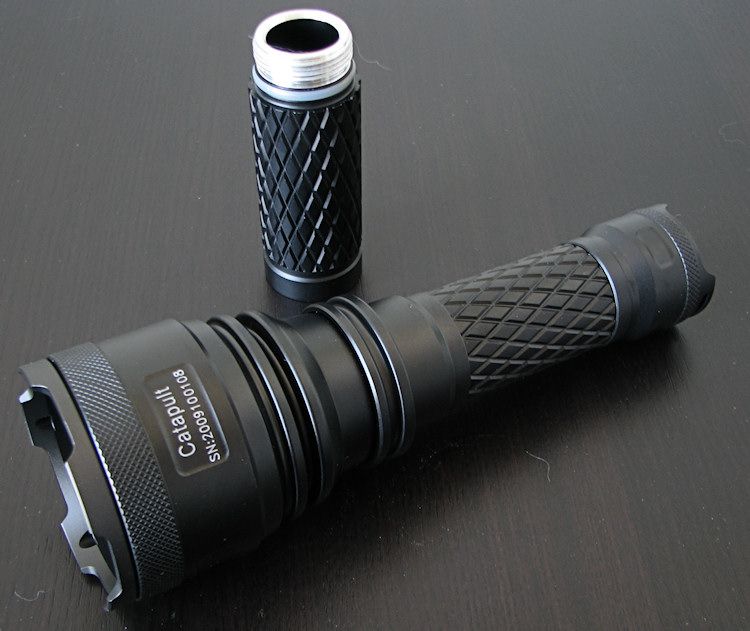
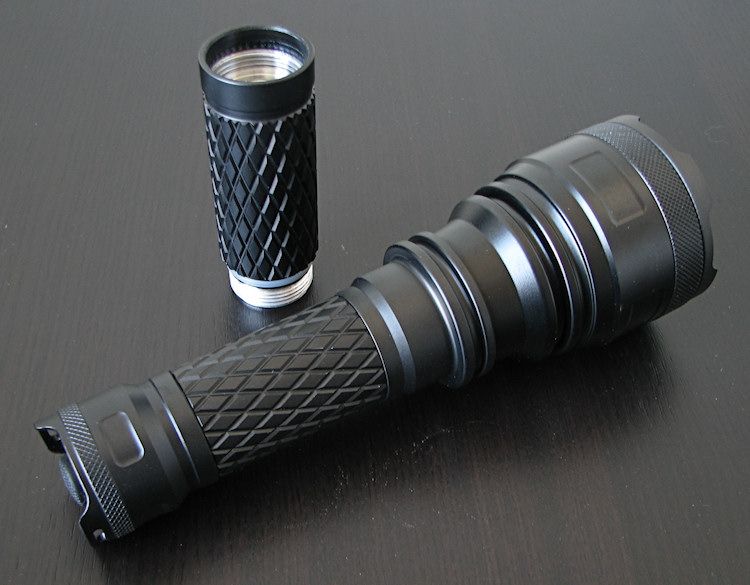
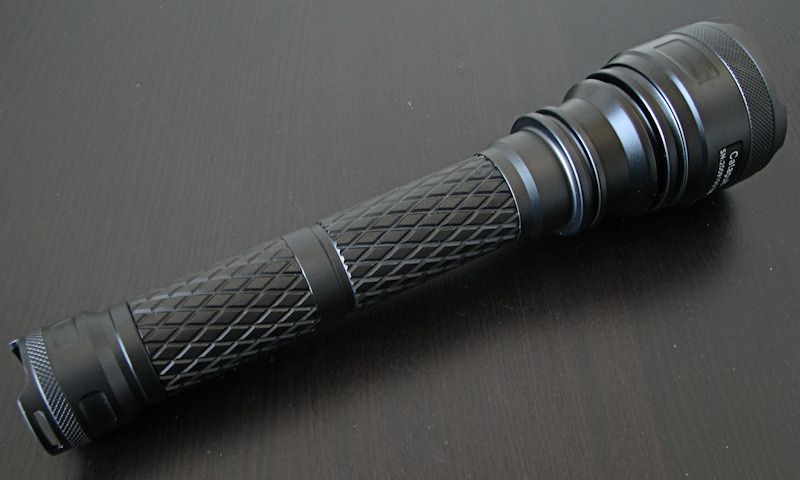
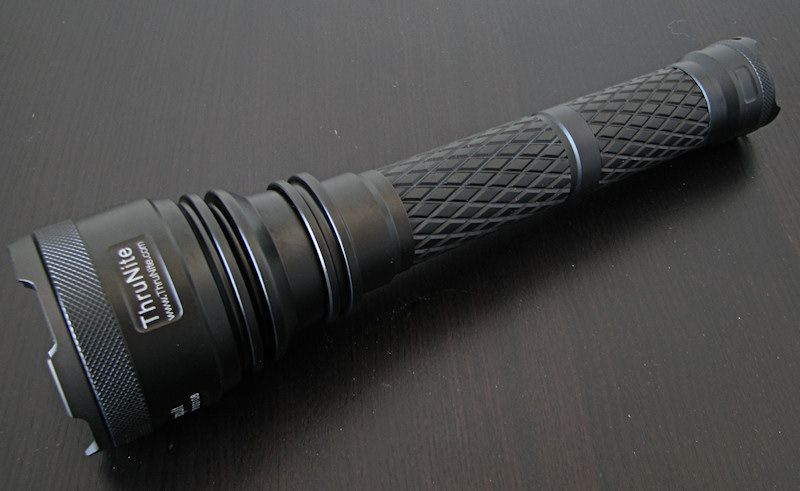
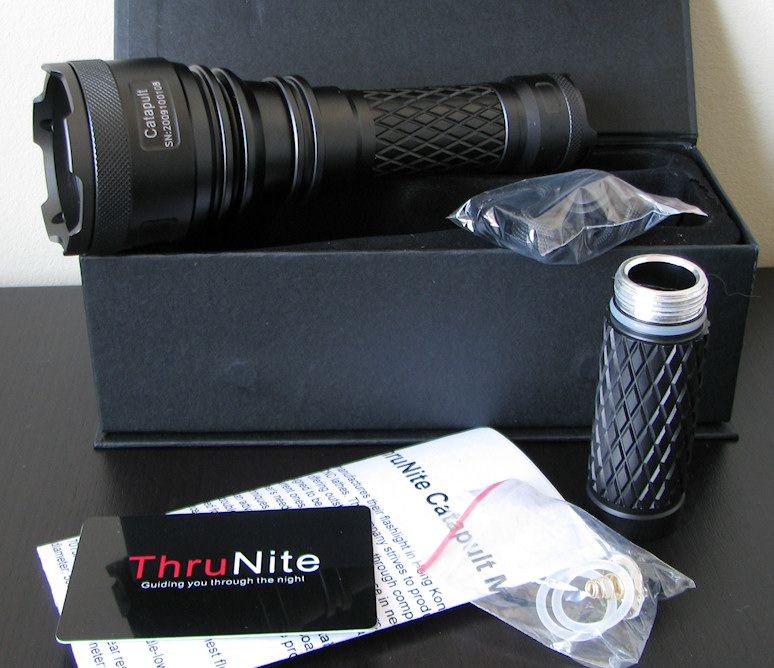
The light comes with a fairly standard set of extras, in a hard cardboard box with magnetic closing flap. Inside, you will find the light, extension body tube, warranty card, wrist lanyard, spare o-rings and extra tailcap clicky switch.
Here is how it looks in my hands, and compared to a couple lights of its class:
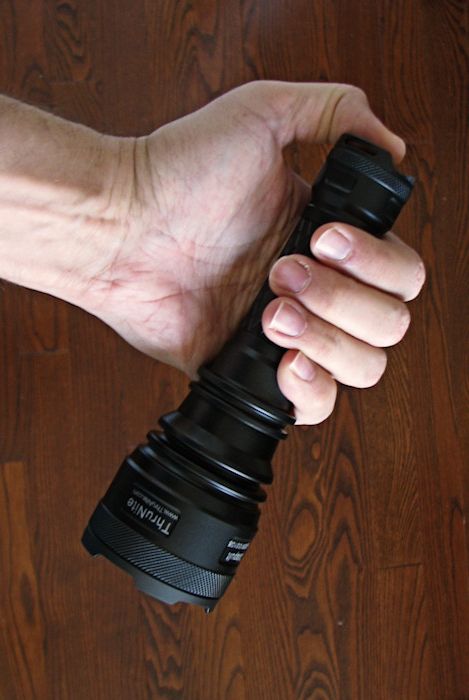
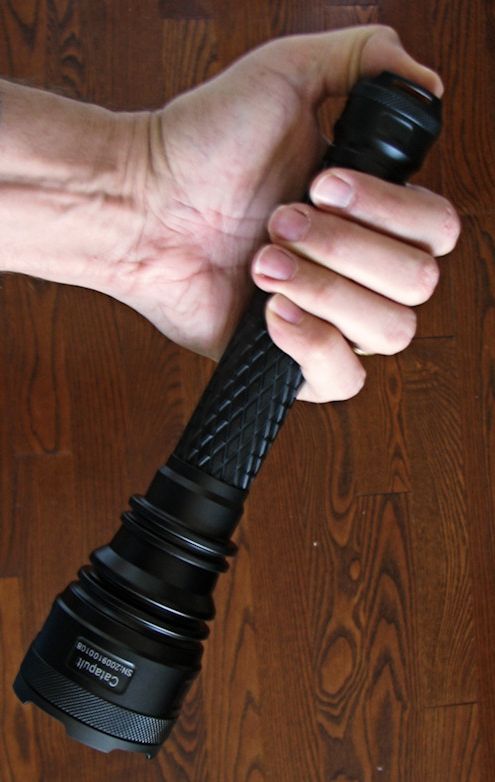
And in comparison to other lights:
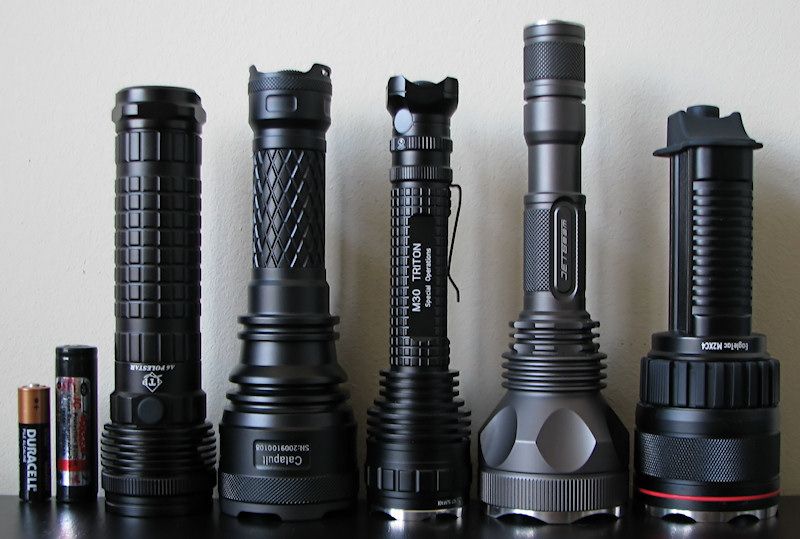
From left to right: Duracell AA battery, AW 18650 protected battery, ITP A6, ThruNite Catapult, Olight M30, JetBeam M1X, EagleTac M2XC4, JetBeam M1X (all in base configuration, no extenders)
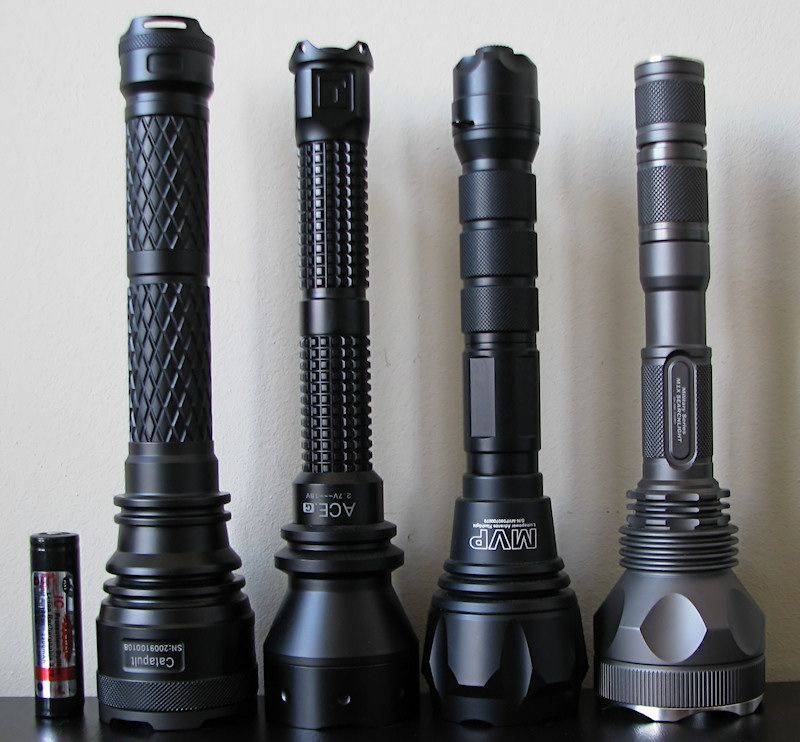
From left to right: AW 18650 protected battery, ThruNite Catapult, Tiablo ACE-G, Lumapower MVP, JetBeam M1X.
Catapult Weight (no battery): 339.3g (no extender, 410.5g (with extender)
Catapult Dimensions: Length: 185mm (no extender) 250mm (with extender), Width (bezel) 59.0mm, Width (tailcap) 34.4mm
As you can tell from above, this is a substantial light. oo: It is one of the heaviest of its class, and probably has the thickest aluminum walls I've ever seen on a light. When I handed it over to Mrs Selfbuilt, she swung around it around a few times – getting the weight of it - and then smacked it into her open palm before pronouncing she liked this light :devil: (and I hadn't even turned it on yet
oo: It is one of the heaviest of its class, and probably has the thickest aluminum walls I've ever seen on a light. When I handed it over to Mrs Selfbuilt, she swung around it around a few times – getting the weight of it - and then smacked it into her open palm before pronouncing she liked this light :devil: (and I hadn't even turned it on yet  ).
).
It also has some of deepest cut checkered patterning that I've ever seen on the surface of a light (again, thanks to the thicker walls). I found this greatly helped with grip – no worries about accidentally letting this light slip through your fingers.
Lettering and anodizing were excellent on my sample, although the writing could be a bit brighter. Personally, I prefer it more subtle like this. The bezel crown is made of aluminium like the rest of the light.
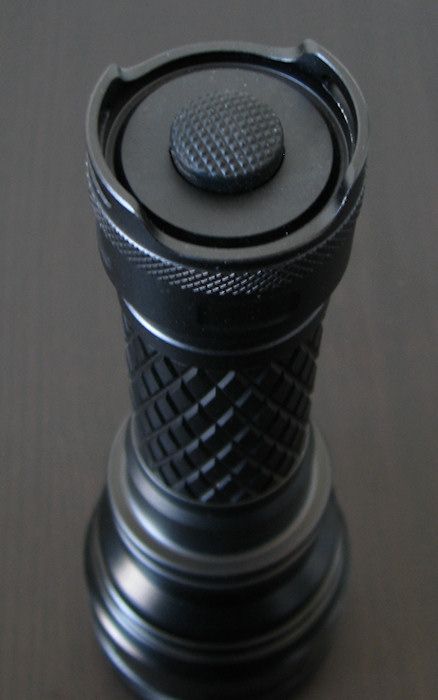
As you can see, the light can tailstand thanks to the raised ridges (which also serve as attachment points for the wrist lanyard). Personally, I find these to be low-profile enough not to get in the way of the forward clicky switch. The width of the tailcap is also sufficient to give most thumbs ample space. The switch has fairly standard forward clicky traverse and feel.
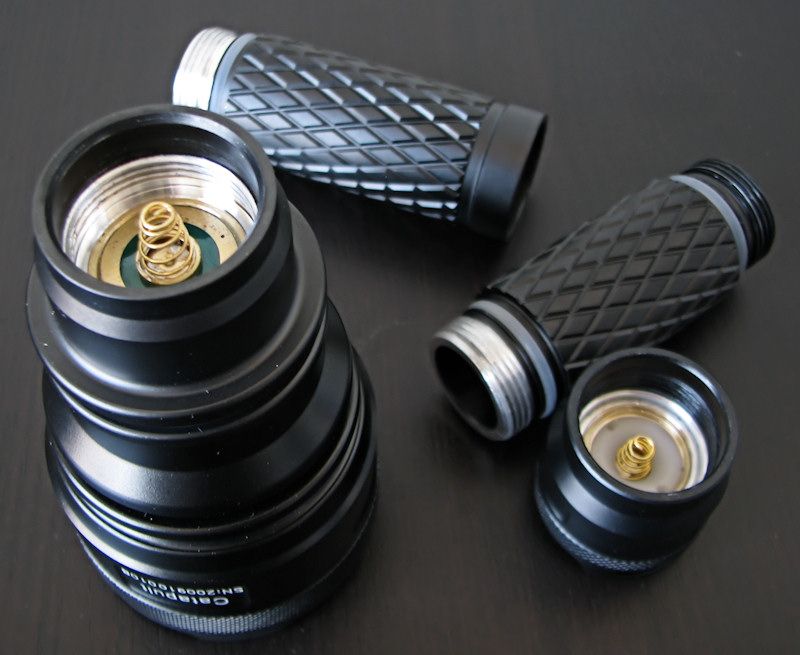
There are gold-plated springs in both the tailcap and mounted on the positive contact board in the head, so flat top cells should work fine. Screw threads in the tailcap and on the corresponding battery tube are anodized, allowing for lock-out. :thumbsup:
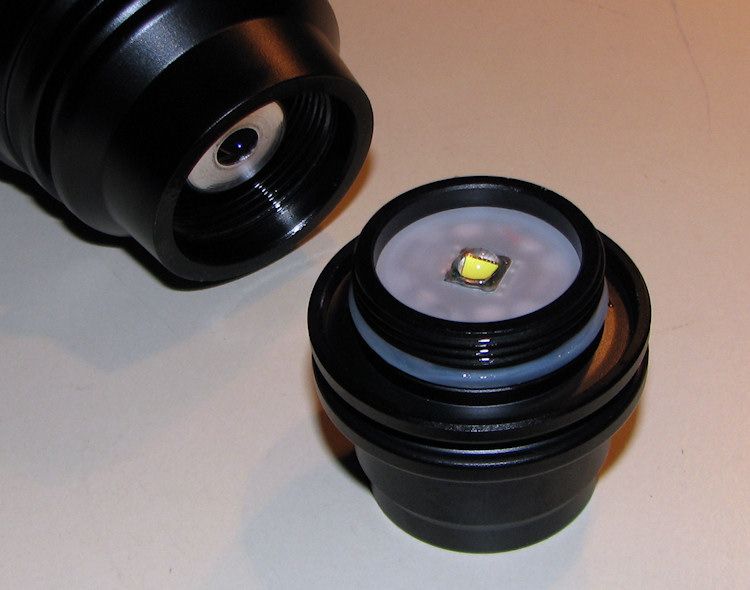
UPDATE 12/15/09: O-rings are thick, and of apparent good quality. However, the one in the head of my light was broken when I opened the head after all the runtime testing (replaced with one of the spares for the pic above). ThruNite believes the damage to mine may have come from all the heat of extensive runtime testing. :shrug: FYI, most of the o-rings on my light were quite dry - I recommend you lube them, to insure a good waterproof seal.
UPDATE 12/20/09: My replacement Catapult came with a much thicker and more opaque insulating disc around the emitter (i.e. you can no longer see the star undernearth, and it is build up higher around the emitter frame). :thumbsup:
An interesting the feature – the extender portion goes between the head and the main body tube, not between the main body tube and switch (as is the case on most other lights). This might give you a moment's pause the first time you install it – if you try to force it the other way, you likely won't be able to make contact given the anodized screw threads intended for the tailcap.
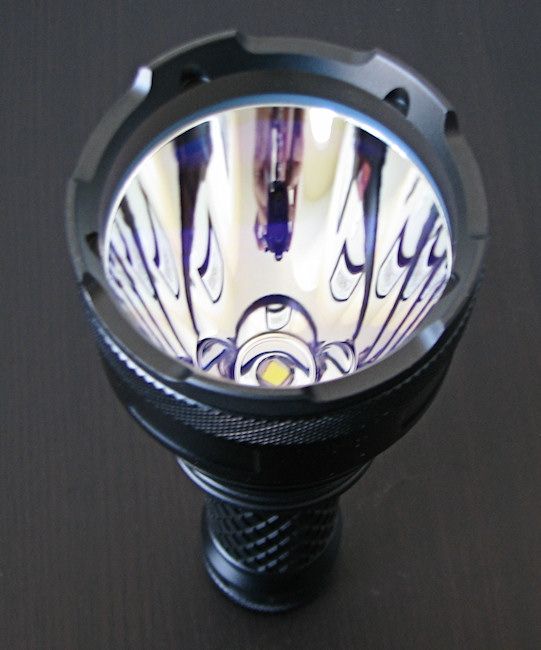
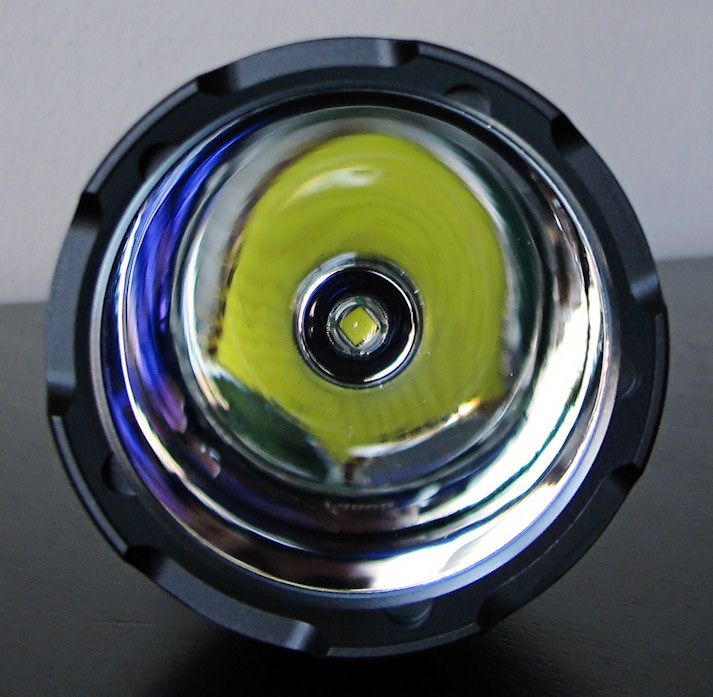
Now this is a lovely sight – the smooth reflector is extremely deep, and the lens is remarkably clear (with a noticeable purplish-tinged anti-glare coating). Together, this makes for a very impressive business-end to this light. Get the feeling it's going to be a thrower?
To start, here are some comparison beamshots against my best MC-E thrower, the JetBeam M1X. Both are done on Max on 18650 AW protected Li-ion. Distance is about 0.5 meters from a white wall.
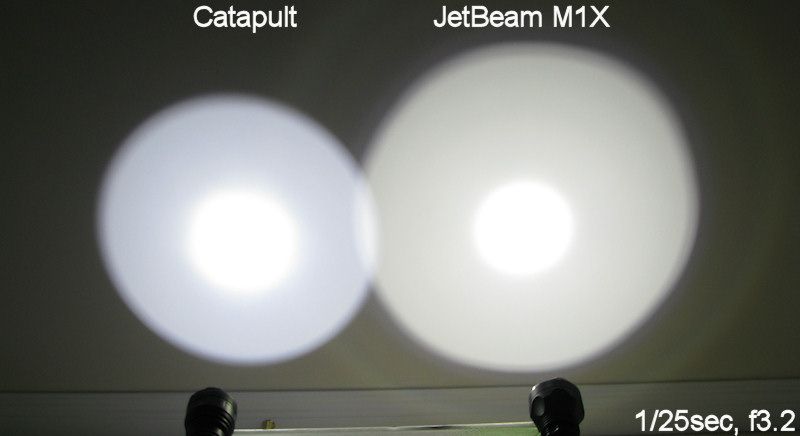
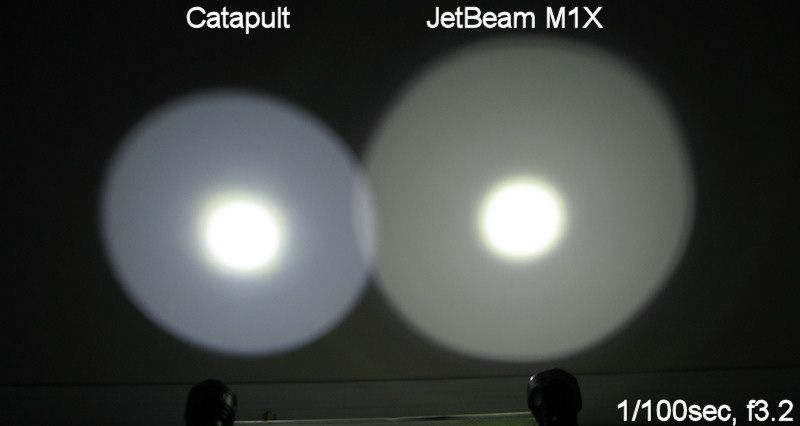
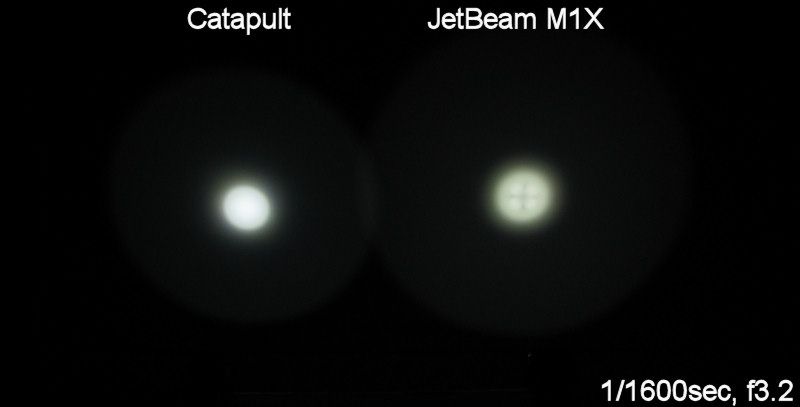
As expected, the throw of the Catapult is within the same range as the M1X – but bonus, there is no sign of the MC-E donut/cross-hatching. :thumbsup: The spillbeam width is a bit narrower, but correspondingly also brighter. There is some slight color distortion around the hotspot (i.e. a bit of blue/yellow in the rings, similar to - but less pronounced - than what you see with Golden Dragon emitters)
UPDATE 12/20/09: The replacement emitter module I received was not quite as well centered as my original sample. This introduces greater colour and pattern variations in the corona around the hotspot in the beam, but doesn't seem to affect max throw.
To give you a better feel for how the beam really looks, I've done some additional shots are just over 5 meters against the M1X, EagleTac M2XC4 and Tiablo A10-G. Again, all are on 2x18650 AW cells. I've kept the exposure low (1/100sec, f3,5) to better show you the hotspots (my apologies for the drywall spackle marks, these are from my unfinished basement ).
).
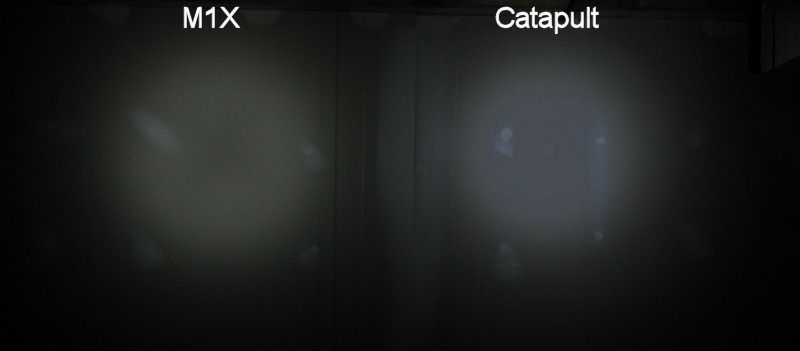
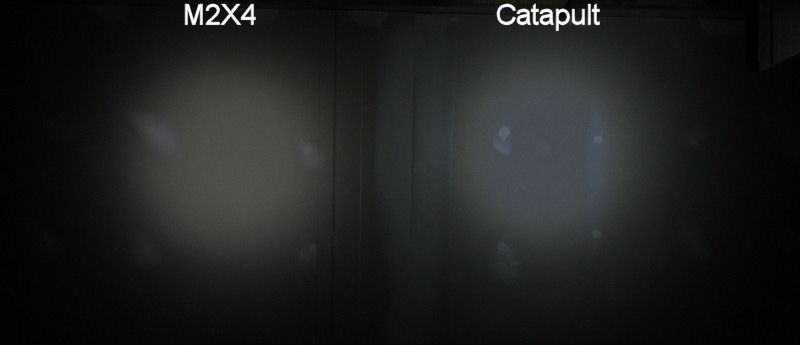
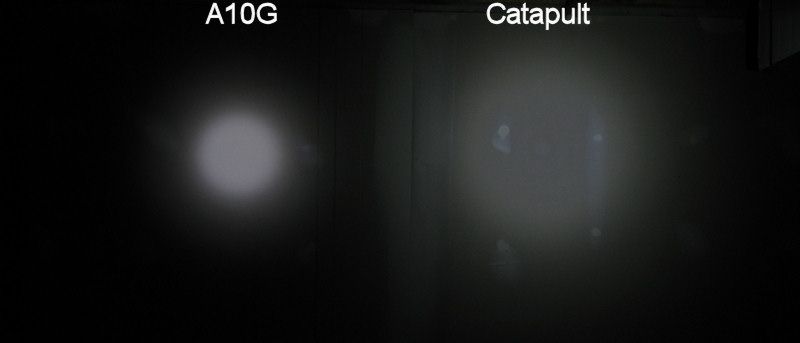
The point here is that the Catapult has a remarkably smooth and well-defined hotspot. It really makes a uniform spot-beam – I've never see anything quite like it. It is wider than most tightly-focused throwers, and very uniform in its appearance. However, if you look closely, you'll see some thin dark rings near the centre of the beam. To be honest, I find these look rather like a nipple in the centre of the beam. :laughing:
:laughing:
I haven't done any real outdoor testing here (snow on the ground, and too many houses around ), but I've tried to give you another idea of what to expect from the hotspot at a medium range distance. These are indoor beamshots of a target "gremlin" at 10m from the lights (1/5sec exposure, f2.7). Click on the images to bring up higher resolution photos.
), but I've tried to give you another idea of what to expect from the hotspot at a medium range distance. These are indoor beamshots of a target "gremlin" at 10m from the lights (1/5sec exposure, f2.7). Click on the images to bring up higher resolution photos.
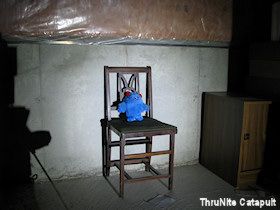
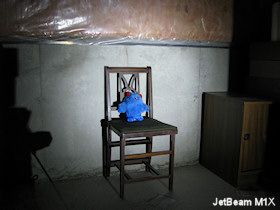
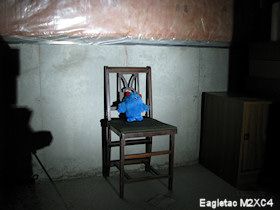

Honestly, I think this emitter/reflector combo is one of the most interesting things I've seen in awhile. It should do very well as a search-and-rescue style light.
User Interface
The Catapult uses a very simple interface – it always comes on in Hi, and you can soft-press the forward clicky to cycle through Med > Lo > Strobe. There is no mode memory.
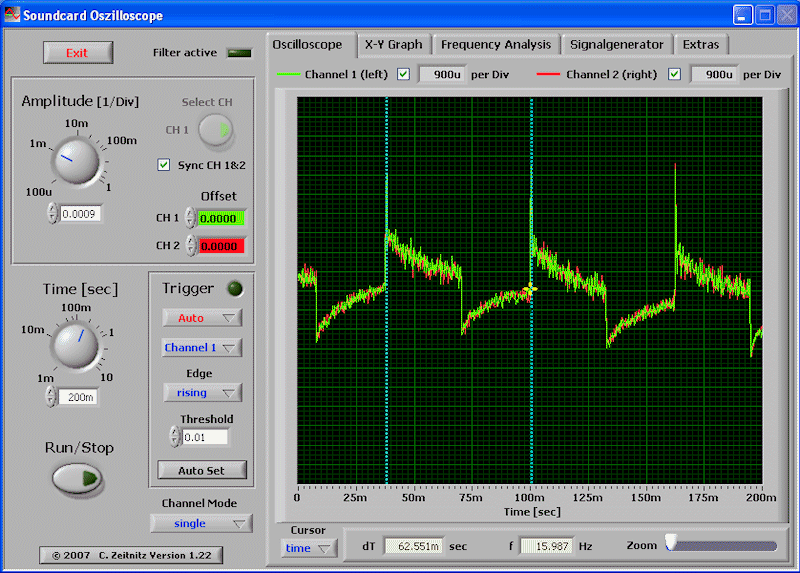
Strobe was measured at a very annoying 16Hz. :green:
I was unable to detect any sign of PWM at any output level with my home-made sound card-oscilloscope setup. :thumbsup: So either the light is current-controlled, or the frequency is incredibly high and undetectable.
 Note the voltage range of the circuit: 2.7V – 8.4V. This means you cannot run the light in 4xCR123A or 4xRCR configurations – you will blow the circuit. The light is clearly meant to run best on 2x18650.
Note the voltage range of the circuit: 2.7V – 8.4V. This means you cannot run the light in 4xCR123A or 4xRCR configurations – you will blow the circuit. The light is clearly meant to run best on 2x18650.
I note the manual states that 2xCR123A and 2xRCR are supported, but then goes on to warn that they "never suggest" you use it this way, as the high current may be dangerous for these batteries. Battery Junction's website specifically warns not to use CR123A or RCR at all in the light!
In practical terms, I think 2xCR123A/RCR would be fine as long as you limit yourself to Lo or Med only, and not Hi or Strobe. Remember again that the light always comes on in Hi mode first. I have tested these 2x configs on Med/Lo (see runtimes for more info).
One interesting additional feature – the circuit has a low voltage flash and cut-off feature. When cells go below ~5.2V, the light will give you two series of rapid flashes to warn you. It does not continue to flash beyond this. It will also cut-off completely at 2.7V. I mention this because I noticed the warning flash was triggered immediately when I tried 2xCR123A primary cells. As the cells neared depletion, the light also abruptly cut-off (again, scroll down for runtime traces).
As a side note, I found inductor whine (i.e. the high-pitch hissing) to be quite loud on Hi and Strobe on my sample, on all batteries. This is a common feature for many modern lights, and is quite variable in its presentation, so I don't normally comment on it. But the Catapult has to be one of the loudest ones I've ever heard, so I'm curious as to what other users experience is. :shrug:
UPDATE 12/20/09: ThruNite thinks my original sample was defective, hence the loud inductor whine and eventual shorting out. The replacement sample has a barely audible whine on Hi/Med, far more in keeping with other lights.
Testing Method: All my output numbers are relative for my home-made light box setup, a la Quickbeam's flashlight reviews method. You can directly compare all my relative output values from different reviews - i.e. an output value of "10" in one graph is the same as "10" in another. All runtimes are done under a cooling fan.
Throw values are the square-root of lux measurements taken at 5 meters from the lens, using a light meter, and then extrapolated back to estimate values for 1 meter. This will be my standard way to present throw on these types of lights from now on. The beams don't really have a chance to fully converge until typically several meters out
Some of the other lights take a couple of minutes to settle into their regulated output state (i.e. their initial output is higher, but not for long). As such, all my output and throw numbers are taken after 2 mins of continuous runtime (on 2x18650 AW Protected cells).
Throw/Output Summary Chart:
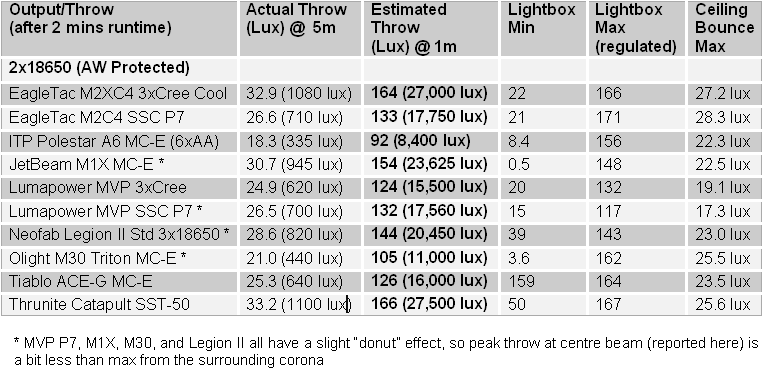
Consistent with what you saw in the beamshots, the Catapult's throw (as measured at centre-beam at 5m) is right up there with the M1X and M2XC4. But these numbers don't really tell the whole story. At greater distance, I believe the Catapult and the M1X both out-throw the M2XC4.
Output/Runtime Comparison
All 18650 runtimes were done on AW protected cells (2200mAh).
2x Battery Configurations:
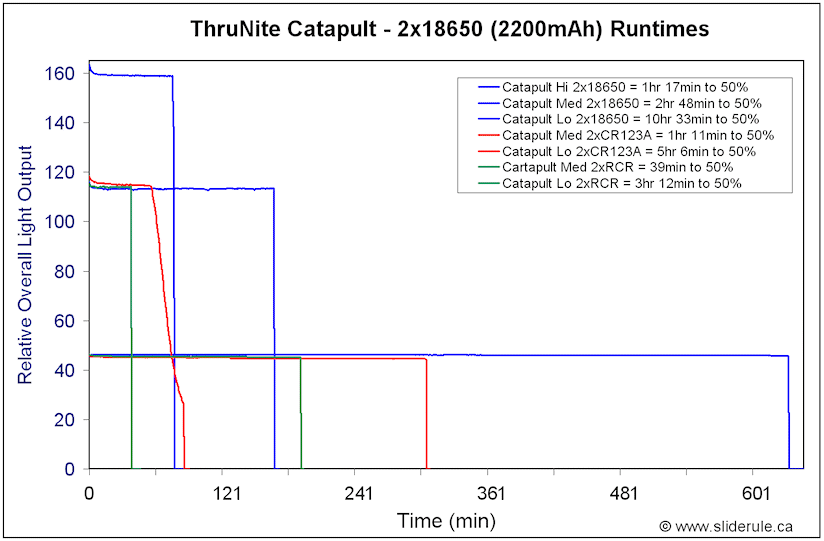
The manufacturer's specs in terms of output levels and runtimes appear to be fairly accurate. I suspect they were using sligthtly higher capacity 18650s in their testing (I use 2200mAh AW protected cells).
As you can see, 2xCR123A and 2xRCR both worked fine at Med/Lo levels – despite the low voltage cut-off on CR123A. Again, do NOT attempt to run this light on Hi on these cells – you would be greatly exceeding their specified current drain levels.
Output levels are well-spaced, but I wouldn't consider any of them particularly "low".
1x and 2x18650 Configurations:
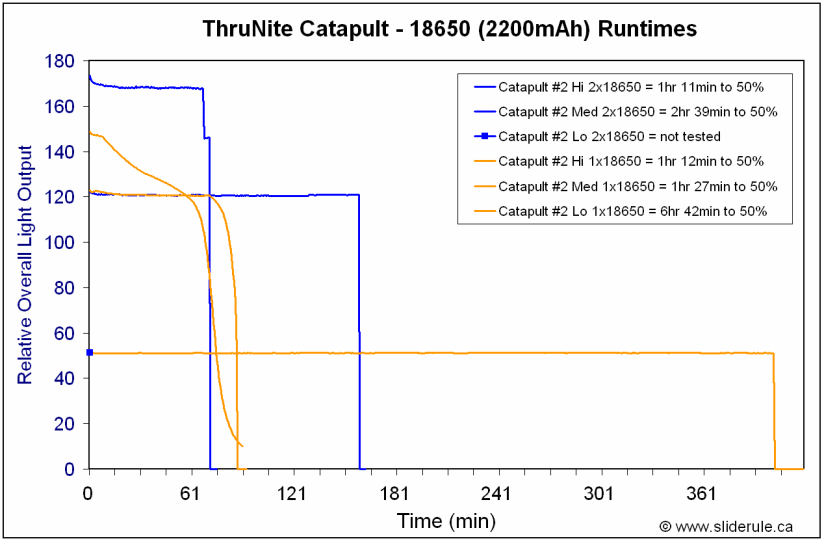
UPDATE 12/20/09: I've added 1x18650 runs to the graph above. Note these runtimes are a little different from the other ones shown here, since they are based on a replacement Catapult that had slightly greater output (but slightly lower runtime) than the one I originally tested. The difference isn't great (and well within emitter variability), but I re-did some of the 2x18650 runs in the graph above so that you could directly compare outputs.
As you can see above, the light runs on 1x18650, but at lower - and non-regulated - max output. Med/Lo are the same output levels as 2x18650 configuration, with just lower regulated runtime.
Here is how they compare to the MC-E/P7 competition:
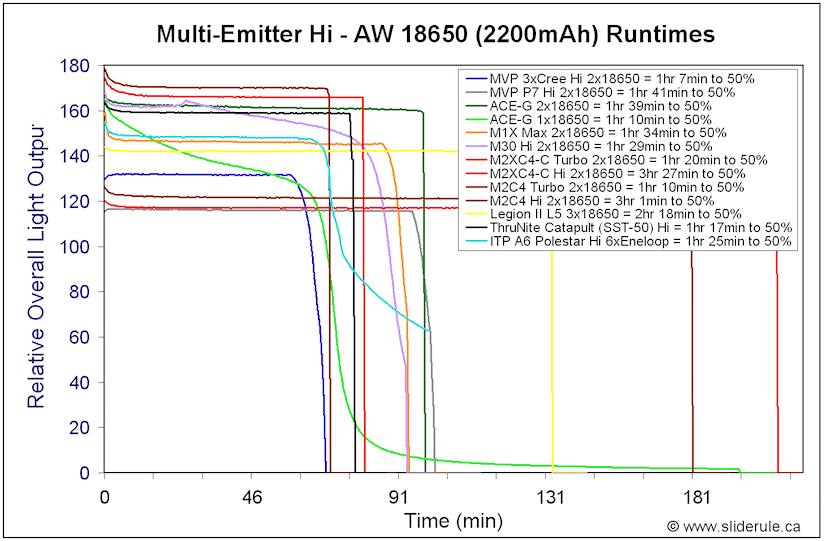
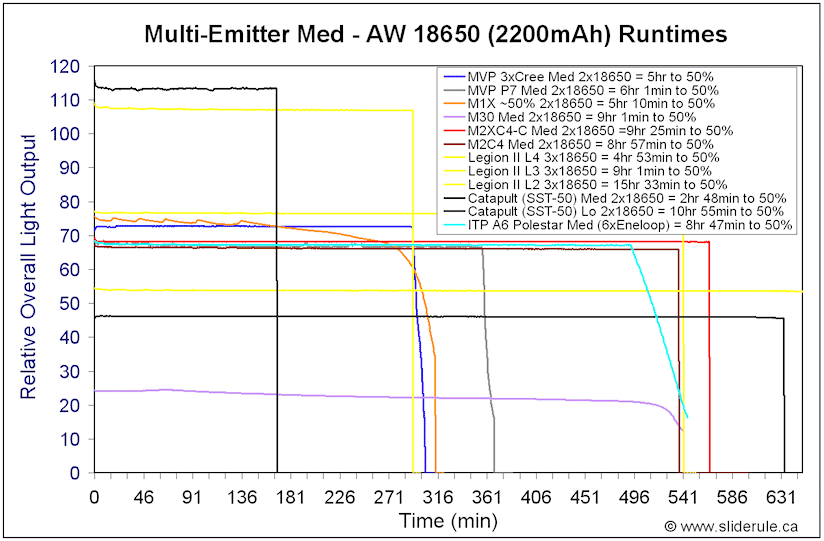
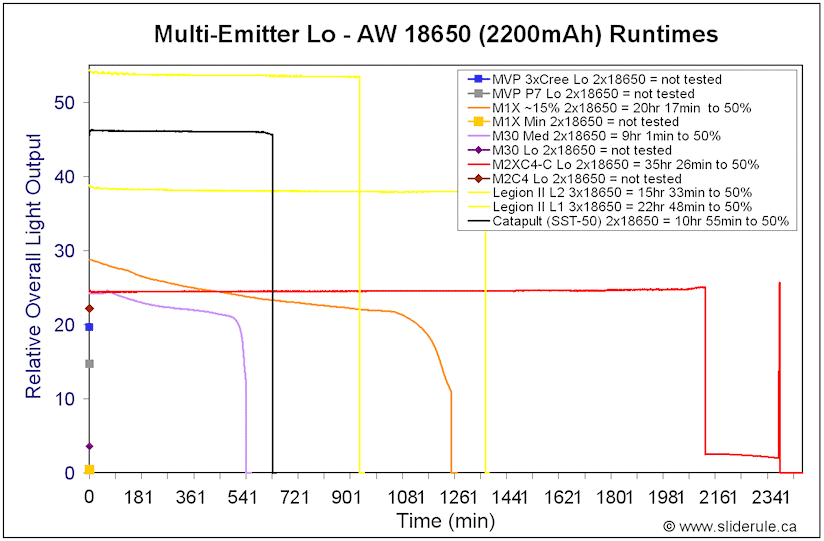
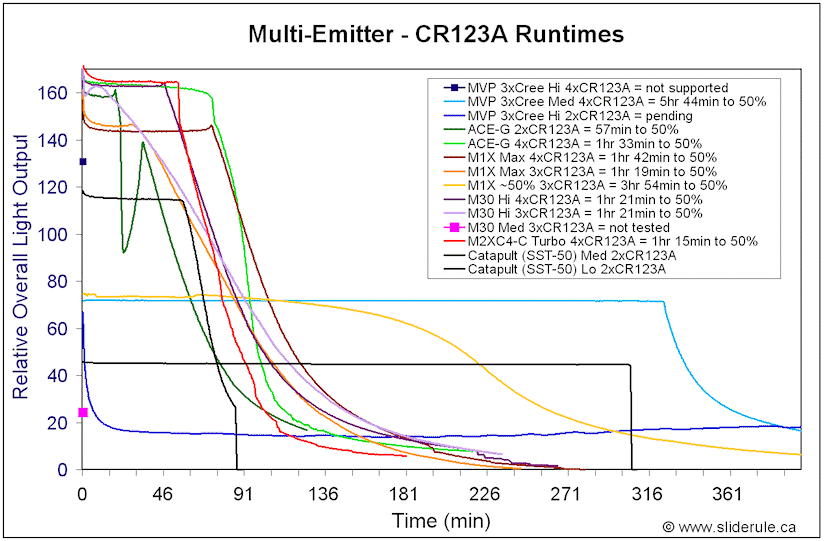
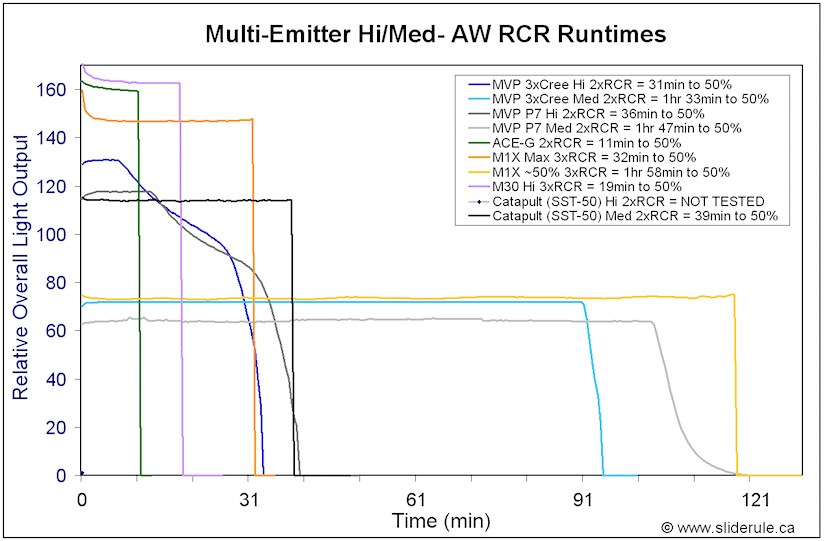
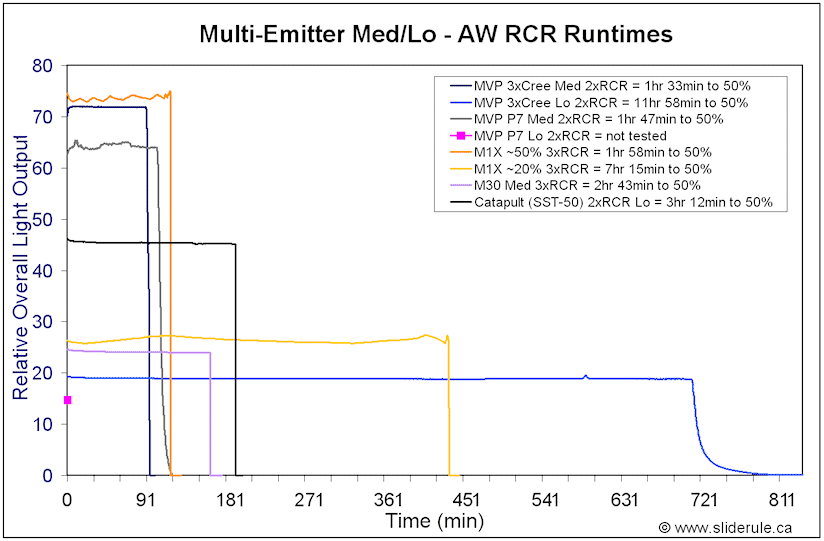
In general terms, the Catapult holds its own well enough, but overall efficiency doesn't seem to quite match most of the more recent MC-E/P7 lights.
Potential Issues
UPDATE 12/20/09: On my first sample, it was possible to over-tighten the reflector/head housing and come into physical contact with the emitter (in fact, I may have shorted out my first sample this way). The replacement emitter module ThruNite sent me had a thicker insulating disc, so this no longer seems to be a problem.
Unlike a lot of the MC-E/P7 competition, the Catapult has a narrower voltage range that doesn't allow 4x cell configurations. Also, max output on 2xCR123A and 2xRCR are not recommended, as the current draw on Hi/Strobe would greatly exceed what those cells are capable of providing (and risks damaging the cells). You can run the light on 1x18650, but Hi mode is lower output and not regulated. This is basically a 2x18650 light, with the potential to run 2xCR123A/RCR or 1x18650 in a pinch (and ONLY on Lo/Med).
The user interface is pretty basic, and lacks a memory mode. The light always comes in Hi mode,
Although output levels are reasonably well spaced, the light lacks a true Lo mode.
As with many lights of this size and class, no belt holster is provided (to date).
Preliminary Observations
The beam profile of this light is very unique – and frankly, very appealing. Given all my testing, it's rare to come across a light that make me go oo: when I first turn it on. This is definitely one of those lights: huge output, great throw, and a remarkably uniform hotspot free of surrounding rings.
oo: when I first turn it on. This is definitely one of those lights: huge output, great throw, and a remarkably uniform hotspot free of surrounding rings. 
Much of this has to do with the large single-die emitter and extremely deep reflector, producing a wonderful true "spotbeam". The M1X was another example of a light that made me sit up and take notice upon arrival – but in playing with both of them, I find I prefer the much more uniform spotbeam produced by the Catapult. Either would do very well for you as a search-and-rescue light, but Catapult's beam is definitely "prettier". :kiss:
Of course, there's more to a light than optics alone. Build-wise, I certainly have no complaint with the Catapult. It is solid like a tank, well-balanced with good hand-feel and grip. The anodized screw threads, forward clicky switch, and tail-standing and head-standing features also all speak well for it. The overall impression is one of quality construction on fairly beefy scale. In contrast, I would rate the M1X (also a quality light) as having a more elegant and refined feel. Different strokes for different folks.
Output and runtime efficiency are certainly acceptable – performance is definitely within the same class as my higher-end MC-E/P7 lights. But this is where I start to have some concerns. First is the more restricted voltage range, limiting your battery options (i.e. no 4x configurations possible). Coupled with the excessive current draw on Hi/Strobe, you are basically reduced to 2x18650 for full feature/performance (i.e. CR123A/RCR can't safely handle those discharge rates, 1x18650 is not as bright or regulated on Hi). The heavy current draw also make me wonder about the long-term stability of the clicky switch – but it is thoughtful of ThruNite to throw in a spare switch into the package.
The UI also seems a little too basic to me – I can understand and accept the Hi > Med > Lo > Strobe sequence for a thrower light, but why no memory feature? While I know some members here don't like mode memory, it seems to me it would at least provide greater flexibility for the rest of us. Similarly, I know a lot of people may not see the need for a truly low Lo mode on a thrower light, but I would have liked to have seen something a bit lower here. This is one area where the continuously-variable M1X is hard to top, although I can at least commend ThruNite on keeping the PWM at undetectable levels.
As previously mentioned, this is my first review of a Luminus SST-50 equipped light. I am impressed with the tint and beam profile of this specimen, and am looking forward to seeing further examples (note that if your emitter is not perfectly centered, you may experience some color/pattern distortions around the hotspot periphery). Simply put, it's nice to be able to get the equivalent output of a quad-die MC-E/P7 (and potentially more!) without the visual limitations of the quad-die (i.e reduced focusing ability for throw, centre-beam donut/cross-hatch, etc).
At the end of the day, ThruNite has done an excellent job of matching this emitter with a deep reflector for a truly spectacular spotlight beam - Catapult is a good name for it! :laughing: They also impress with their ability to produce a solid, well-crafted body with good build features. The one area where I think some refinement is needed is in the circuit – both for feature set and battery flexibility. But as always, it comes down to what you are looking for in a light – and there is already a lot to commend in this offering.
UPDATE 6/4/10: A new V2 Catapult is now out, with a revised interface and greater voltage range/battery support. Please see my new V2 review for more info.
UPDATE 6/4/10: A new V2 Catapult is now out, with a revised interface and greater voltage range/battery support. Please see my new V2 review for more info.
UPDATE 12/20/09: Added 1x18650 runtimes and additional comments from replacement sample.
Warning: exceptionally pic heavy
Manufacturer Specifications: (taken from BatteryJunction's website)
- World-class super bright Luminus SST-50 emitter
- Maximum of 950 emitter lumens on high (~700 OTF)
- 3 Output Levels and Strobe: (using 2 x 18650 batteries)
- High 900 Lumens / 1.4 hours
- Medium 520 Lumens / 3 hours
- Low 125 Lumens / 13.5 hours
- Strobe 900 lumens / 2 hours
- Cutting-edge reverse polarity protection
- Operating voltage between 2.7V to 8.4V
- Drive Current to LED:High 3A, Medium 1.5A, Low 750ma
- Mil-Spec Type III Hard Anodized
- Constructed of 7075AL for superior durability Length: 185mm; Head diameter: 58mm; Body diameter: 31mm; Weight: 390g. (Extended tube excluded)
- Tactical momentary-on forward click switch
- IPX-68 Water/Dust Resistane
- Tail cap design allows the light to tail stand
- Anti-shatter ultra clear lens with double-sided multilayer AR coating
- smooth reflector for throw BATTERY OPTIONS: 1x 18650 / 1 x 17670 / 2 x 18650 / 2 x 17670 (2 x 18650 recommended for optimum performance!)
- Note: Do not use CR123 or RCR123A / 16340 batteries in the Catapult!
- Voltage cut-off occurs at 2.7V to protect rechargeable batteries. It will flash at 5.2V to indicate low battery voltage for two Rechargeable batteries.
- CPF price: $150
To date, ThruNite is best known for its small titanium keychain light, the TiKey. The Catapult is a new direction for the group - a high-end, high-output thrower.





The light comes with a fairly standard set of extras, in a hard cardboard box with magnetic closing flap. Inside, you will find the light, extension body tube, warranty card, wrist lanyard, spare o-rings and extra tailcap clicky switch.
Here is how it looks in my hands, and compared to a couple lights of its class:


And in comparison to other lights:

From left to right: Duracell AA battery, AW 18650 protected battery, ITP A6, ThruNite Catapult, Olight M30, JetBeam M1X, EagleTac M2XC4, JetBeam M1X (all in base configuration, no extenders)

From left to right: AW 18650 protected battery, ThruNite Catapult, Tiablo ACE-G, Lumapower MVP, JetBeam M1X.
Catapult Weight (no battery): 339.3g (no extender, 410.5g (with extender)
Catapult Dimensions: Length: 185mm (no extender) 250mm (with extender), Width (bezel) 59.0mm, Width (tailcap) 34.4mm
As you can tell from above, this is a substantial light.
It also has some of deepest cut checkered patterning that I've ever seen on the surface of a light (again, thanks to the thicker walls). I found this greatly helped with grip – no worries about accidentally letting this light slip through your fingers.
Lettering and anodizing were excellent on my sample, although the writing could be a bit brighter. Personally, I prefer it more subtle like this. The bezel crown is made of aluminium like the rest of the light.

As you can see, the light can tailstand thanks to the raised ridges (which also serve as attachment points for the wrist lanyard). Personally, I find these to be low-profile enough not to get in the way of the forward clicky switch. The width of the tailcap is also sufficient to give most thumbs ample space. The switch has fairly standard forward clicky traverse and feel.

There are gold-plated springs in both the tailcap and mounted on the positive contact board in the head, so flat top cells should work fine. Screw threads in the tailcap and on the corresponding battery tube are anodized, allowing for lock-out. :thumbsup:

UPDATE 12/15/09: O-rings are thick, and of apparent good quality. However, the one in the head of my light was broken when I opened the head after all the runtime testing (replaced with one of the spares for the pic above). ThruNite believes the damage to mine may have come from all the heat of extensive runtime testing. :shrug: FYI, most of the o-rings on my light were quite dry - I recommend you lube them, to insure a good waterproof seal.
UPDATE 12/20/09: My replacement Catapult came with a much thicker and more opaque insulating disc around the emitter (i.e. you can no longer see the star undernearth, and it is build up higher around the emitter frame). :thumbsup:
An interesting the feature – the extender portion goes between the head and the main body tube, not between the main body tube and switch (as is the case on most other lights). This might give you a moment's pause the first time you install it – if you try to force it the other way, you likely won't be able to make contact given the anodized screw threads intended for the tailcap.


Now this is a lovely sight – the smooth reflector is extremely deep, and the lens is remarkably clear (with a noticeable purplish-tinged anti-glare coating). Together, this makes for a very impressive business-end to this light. Get the feeling it's going to be a thrower?
To start, here are some comparison beamshots against my best MC-E thrower, the JetBeam M1X. Both are done on Max on 18650 AW protected Li-ion. Distance is about 0.5 meters from a white wall.



As expected, the throw of the Catapult is within the same range as the M1X – but bonus, there is no sign of the MC-E donut/cross-hatching. :thumbsup: The spillbeam width is a bit narrower, but correspondingly also brighter. There is some slight color distortion around the hotspot (i.e. a bit of blue/yellow in the rings, similar to - but less pronounced - than what you see with Golden Dragon emitters)
UPDATE 12/20/09: The replacement emitter module I received was not quite as well centered as my original sample. This introduces greater colour and pattern variations in the corona around the hotspot in the beam, but doesn't seem to affect max throw.
To give you a better feel for how the beam really looks, I've done some additional shots are just over 5 meters against the M1X, EagleTac M2XC4 and Tiablo A10-G. Again, all are on 2x18650 AW cells. I've kept the exposure low (1/100sec, f3,5) to better show you the hotspots (my apologies for the drywall spackle marks, these are from my unfinished basement



The point here is that the Catapult has a remarkably smooth and well-defined hotspot. It really makes a uniform spot-beam – I've never see anything quite like it. It is wider than most tightly-focused throwers, and very uniform in its appearance. However, if you look closely, you'll see some thin dark rings near the centre of the beam. To be honest, I find these look rather like a nipple in the centre of the beam.
 :laughing:
:laughing:I haven't done any real outdoor testing here (snow on the ground, and too many houses around




Honestly, I think this emitter/reflector combo is one of the most interesting things I've seen in awhile. It should do very well as a search-and-rescue style light.
User Interface
The Catapult uses a very simple interface – it always comes on in Hi, and you can soft-press the forward clicky to cycle through Med > Lo > Strobe. There is no mode memory.

Strobe was measured at a very annoying 16Hz. :green:
I was unable to detect any sign of PWM at any output level with my home-made sound card-oscilloscope setup. :thumbsup: So either the light is current-controlled, or the frequency is incredibly high and undetectable.
 Note the voltage range of the circuit: 2.7V – 8.4V. This means you cannot run the light in 4xCR123A or 4xRCR configurations – you will blow the circuit. The light is clearly meant to run best on 2x18650.
Note the voltage range of the circuit: 2.7V – 8.4V. This means you cannot run the light in 4xCR123A or 4xRCR configurations – you will blow the circuit. The light is clearly meant to run best on 2x18650. I note the manual states that 2xCR123A and 2xRCR are supported, but then goes on to warn that they "never suggest" you use it this way, as the high current may be dangerous for these batteries. Battery Junction's website specifically warns not to use CR123A or RCR at all in the light!
In practical terms, I think 2xCR123A/RCR would be fine as long as you limit yourself to Lo or Med only, and not Hi or Strobe. Remember again that the light always comes on in Hi mode first. I have tested these 2x configs on Med/Lo (see runtimes for more info).
One interesting additional feature – the circuit has a low voltage flash and cut-off feature. When cells go below ~5.2V, the light will give you two series of rapid flashes to warn you. It does not continue to flash beyond this. It will also cut-off completely at 2.7V. I mention this because I noticed the warning flash was triggered immediately when I tried 2xCR123A primary cells. As the cells neared depletion, the light also abruptly cut-off (again, scroll down for runtime traces).
As a side note, I found inductor whine (i.e. the high-pitch hissing) to be quite loud on Hi and Strobe on my sample, on all batteries. This is a common feature for many modern lights, and is quite variable in its presentation, so I don't normally comment on it. But the Catapult has to be one of the loudest ones I've ever heard, so I'm curious as to what other users experience is. :shrug:
UPDATE 12/20/09: ThruNite thinks my original sample was defective, hence the loud inductor whine and eventual shorting out. The replacement sample has a barely audible whine on Hi/Med, far more in keeping with other lights.
Testing Method: All my output numbers are relative for my home-made light box setup, a la Quickbeam's flashlight reviews method. You can directly compare all my relative output values from different reviews - i.e. an output value of "10" in one graph is the same as "10" in another. All runtimes are done under a cooling fan.
Throw values are the square-root of lux measurements taken at 5 meters from the lens, using a light meter, and then extrapolated back to estimate values for 1 meter. This will be my standard way to present throw on these types of lights from now on. The beams don't really have a chance to fully converge until typically several meters out
Some of the other lights take a couple of minutes to settle into their regulated output state (i.e. their initial output is higher, but not for long). As such, all my output and throw numbers are taken after 2 mins of continuous runtime (on 2x18650 AW Protected cells).
Throw/Output Summary Chart:

Consistent with what you saw in the beamshots, the Catapult's throw (as measured at centre-beam at 5m) is right up there with the M1X and M2XC4. But these numbers don't really tell the whole story. At greater distance, I believe the Catapult and the M1X both out-throw the M2XC4.
Output/Runtime Comparison
All 18650 runtimes were done on AW protected cells (2200mAh).
2x Battery Configurations:

The manufacturer's specs in terms of output levels and runtimes appear to be fairly accurate. I suspect they were using sligthtly higher capacity 18650s in their testing (I use 2200mAh AW protected cells).
As you can see, 2xCR123A and 2xRCR both worked fine at Med/Lo levels – despite the low voltage cut-off on CR123A. Again, do NOT attempt to run this light on Hi on these cells – you would be greatly exceeding their specified current drain levels.
Output levels are well-spaced, but I wouldn't consider any of them particularly "low".
1x and 2x18650 Configurations:

UPDATE 12/20/09: I've added 1x18650 runs to the graph above. Note these runtimes are a little different from the other ones shown here, since they are based on a replacement Catapult that had slightly greater output (but slightly lower runtime) than the one I originally tested. The difference isn't great (and well within emitter variability), but I re-did some of the 2x18650 runs in the graph above so that you could directly compare outputs.
As you can see above, the light runs on 1x18650, but at lower - and non-regulated - max output. Med/Lo are the same output levels as 2x18650 configuration, with just lower regulated runtime.
Here is how they compare to the MC-E/P7 competition:






In general terms, the Catapult holds its own well enough, but overall efficiency doesn't seem to quite match most of the more recent MC-E/P7 lights.
Potential Issues
UPDATE 12/20/09: On my first sample, it was possible to over-tighten the reflector/head housing and come into physical contact with the emitter (in fact, I may have shorted out my first sample this way). The replacement emitter module ThruNite sent me had a thicker insulating disc, so this no longer seems to be a problem.
Unlike a lot of the MC-E/P7 competition, the Catapult has a narrower voltage range that doesn't allow 4x cell configurations. Also, max output on 2xCR123A and 2xRCR are not recommended, as the current draw on Hi/Strobe would greatly exceed what those cells are capable of providing (and risks damaging the cells). You can run the light on 1x18650, but Hi mode is lower output and not regulated. This is basically a 2x18650 light, with the potential to run 2xCR123A/RCR or 1x18650 in a pinch (and ONLY on Lo/Med).
The user interface is pretty basic, and lacks a memory mode. The light always comes in Hi mode,
Although output levels are reasonably well spaced, the light lacks a true Lo mode.
As with many lights of this size and class, no belt holster is provided (to date).
Preliminary Observations
The beam profile of this light is very unique – and frankly, very appealing. Given all my testing, it's rare to come across a light that make me go

Much of this has to do with the large single-die emitter and extremely deep reflector, producing a wonderful true "spotbeam". The M1X was another example of a light that made me sit up and take notice upon arrival – but in playing with both of them, I find I prefer the much more uniform spotbeam produced by the Catapult. Either would do very well for you as a search-and-rescue light, but Catapult's beam is definitely "prettier". :kiss:
Of course, there's more to a light than optics alone. Build-wise, I certainly have no complaint with the Catapult. It is solid like a tank, well-balanced with good hand-feel and grip. The anodized screw threads, forward clicky switch, and tail-standing and head-standing features also all speak well for it. The overall impression is one of quality construction on fairly beefy scale. In contrast, I would rate the M1X (also a quality light) as having a more elegant and refined feel. Different strokes for different folks.
Output and runtime efficiency are certainly acceptable – performance is definitely within the same class as my higher-end MC-E/P7 lights. But this is where I start to have some concerns. First is the more restricted voltage range, limiting your battery options (i.e. no 4x configurations possible). Coupled with the excessive current draw on Hi/Strobe, you are basically reduced to 2x18650 for full feature/performance (i.e. CR123A/RCR can't safely handle those discharge rates, 1x18650 is not as bright or regulated on Hi). The heavy current draw also make me wonder about the long-term stability of the clicky switch – but it is thoughtful of ThruNite to throw in a spare switch into the package.
The UI also seems a little too basic to me – I can understand and accept the Hi > Med > Lo > Strobe sequence for a thrower light, but why no memory feature? While I know some members here don't like mode memory, it seems to me it would at least provide greater flexibility for the rest of us. Similarly, I know a lot of people may not see the need for a truly low Lo mode on a thrower light, but I would have liked to have seen something a bit lower here. This is one area where the continuously-variable M1X is hard to top, although I can at least commend ThruNite on keeping the PWM at undetectable levels.
As previously mentioned, this is my first review of a Luminus SST-50 equipped light. I am impressed with the tint and beam profile of this specimen, and am looking forward to seeing further examples (note that if your emitter is not perfectly centered, you may experience some color/pattern distortions around the hotspot periphery). Simply put, it's nice to be able to get the equivalent output of a quad-die MC-E/P7 (and potentially more!) without the visual limitations of the quad-die (i.e reduced focusing ability for throw, centre-beam donut/cross-hatch, etc).
At the end of the day, ThruNite has done an excellent job of matching this emitter with a deep reflector for a truly spectacular spotlight beam - Catapult is a good name for it! :laughing: They also impress with their ability to produce a solid, well-crafted body with good build features. The one area where I think some refinement is needed is in the circuit – both for feature set and battery flexibility. But as always, it comes down to what you are looking for in a light – and there is already a lot to commend in this offering.
UPDATE 6/4/10: A new V2 Catapult is now out, with a revised interface and greater voltage range/battery support. Please see my new V2 review for more info.
Last edited:


